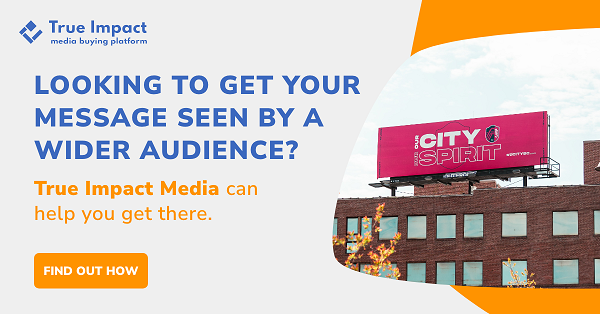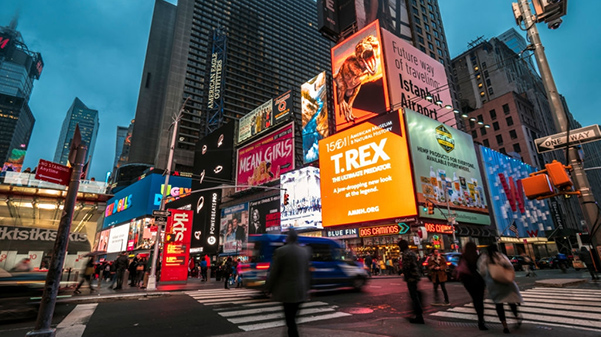We often hear the debate of which is better for marketing, billboards, or social media. The answer is that it depends on your specific campaign and what you are trying to achieve.
From painted street advertisements and giant projection ads to pop-up retail stores, the many methods of guerrilla advertising offer unique and exciting opportunities for brands and businesses to reach potential customers and make an impact.
But what is guerrilla marketing? The short answer is, it’s an interactive advertising method that relies on the element of surprise, out-of-the-box techniques, and consumer interaction to market a brand, service, or product.
But the truth, as far as the different types of OOH advertising methods go, is that guerrilla advertising is a vibrant and versatile marketing strategy that allows businesses to get their messages to their target market in many unique ways. This guide will walk you through some of the most common guerrilla advertising tactics and how they can work for your business.
Defining Guerrilla Marketing
Let’s get a little bit more specific about what’s meant when we discuss guerrilla marketing.
The term was first coined in the 1980s by Jay Conrad Levinson, who adapted the term from “guerrilla warfare.” In a military sense, “guerrilla” refers to armies that use surprising or non-standard ways of attacking their enemies. In advertising, unconventional methods are used with the aim of catching consumers by surprise and therefore making them more likely to:
- See your ad
- Interact with your ad
- Purchase your product or service
How is Guerrilla Advertising Different from Other Kinds of Advertising?
Guerrilla marketing is distinguished from other kinds of advertising by virtue of its flair for the unconventional. During a guerrilla marketing campaign, standard forms of advertising, like static billboards, video ads, and print ads, are abandoned in favor of unexpected options.
Guerrilla campaign ads might appear on public features like streets, fences, or other structures. They may also take the form of live-action spectacles like flash mobs or dance performances. In fact, the nearly unlimited options for advertising in a guerrilla fashion is part of what makes the method so appealing—and so effective.
By tapping into the element of surprise, guerrilla campaign advertisements are able to connect with potential customers on an emotional level, whether that emotion is a surprise, laughter, or something more sentimental. This helps businesses make a lasting impression.
Types of Guerrilla Marketing
The flexibility and versatility of guerrilla marketing actions means that the various forms it can take are quite numerous. As a method that thrives on the unexpected, coming up with new ways to advertise is a big part of guerrilla marketing efforts.
That said, there are several common methods that advertisers return to again and again. Here are some of the most popular examples of guerrilla marketing tactics.1
- Viral or buzz marketing – Long before there was an Internet to go viral, guerrilla marketers were relying on buzz and word-of-mouth to drum up publicity. By stoking conversation in person, online, and on social media, guerrilla marketers spread the word about their product.
- Ambient marketing – Ambient marketing efforts refers to advertising techniques that seek to reach consumers going about their everyday lives. Although unexpected, these ads seek to infuse themselves into the environment, like appearing on coasters or toilets. Advertising in airports, in taxis, and on trains are further examples.
- Ambush marketing – A controversial form of guerrilla advertising, ambush marketing is when an event is “ambushed” and appropriated to promote an unassociated product or service.
- Presence marketing – Presence marketing takes the opposite tack from ambush marketing. It aims to integrate a product or service into an environment so that it is or seems to be always there.
- Sensation marketing – Flash mobs, dance troupes, and impromptu performances are just some of the kinds of sensation marketing that advertisers rely on. As the name suggests, they cause a sensation in a given location.
- Stealth marketing – Among the sneakiest advertising methods, stealth marketing attempts to advertise to consumers without their knowledge.2 Product placement is a common example of this, as are people who drum up conversation about a product or service in a public setting.
- Astroturfing – With its reference to the iconic fake grass, astroturfing refers to the practice of a company building false or artificial buzz around their product in order to drum up attention.3
- Wild posting – Wild posting is when a public wall, fence, or other visible surface is papered over with multiple posters advertising a single product or service.
- Alternative marketing – Alternative marketing can be as difficult to pull off as it is hard to define. It refers to marketing that seems to be completely disconnected from the product in question. Often, brands or businesses will manufacture an event in order to drum up publicity.
- Experiential marketing – Experiential marketing refers to advertisements that seek to give consumers an experience. Frequently, consumers are encouraged to participate in the ad, either by walking through it or physically engaging with it.
- Grassroots advertising – While other advertising forms aim to reach and influence as many people at a single time as possible, grassroots advertisements take a different approach. The goal of grassroots advertising is to spread the word about a product or service one person at a time.
- Projection ads – These ads project large-scale images onto large public structures like buildings. Dazzling images, vibrant color, and even 3D technologies make these eye-catching ways of advertising.
- Pop-up retail – Pop-up shops—temporary stores where consumers can buy directly from brands—are a popular way to turn immediate profits on an ad campaign.
- Streetscapes – Advertisements placed directly on streets and sidewalks, either with pants, stencils, or stickers, are an effective and popular method of guerrilla advertising.
Who Uses Guerrilla Marketing Tactics?
The truth is, brands and businesses of all kinds can benefit from infusing their marketing campaigns with one or two guerrilla elements—and many of them do.
Versatile, flexible, and adaptable from location to location and audience to audience, guerrilla marketing actions are an attainable method for any business, including:
- Small businesses – Because of the low overhead costs associated with many guerrilla marketing tactics, small businesses can have the opportunity to increase their community involvement and brand awareness without breaking the bank.
- Big corporations – From Burger King to Coca Cola to Red Bull, large corporations, too, are getting into the guerrilla marketing game.4
- Nonprofits – Again, thanks to the relatively cheap investment required and the range of possibilities it entails, many nonprofits have found guerrilla marketing to be a productive method of marketing their services.
Pros and Cons of Guerrilla Marketing
Like any method of advertising, guerrilla marketing has its benefits and its drawbacks. On the one hand, it can be a relatively cheap and effective way of reaching consumers. But on the other hand, it can pose a few obstacles.
Here are some of the pros and cons of guerrilla marketing.5
Pros of Guerrilla Marketing
The best of what guerrilla marketing has to offer your brand or business includes:
- Cost-effectiveness – Compared to other methods of advertising, guerrilla marketing tactics are often less expensive—especially when you consider the potential return on your investment that they offer.
- Creative opportunities – For businesses and brands that thrive on reinvention and stay relevant and exciting, guerrilla marketing is a great way to stand out from the crowd.
- Viral potential – Sometimes, the best advertising is free. guerrilla tactics come with great viral potential, both online and in the real world.
Cons of Guerrilla Marketing
Despite its positive qualities, though, guerrilla marketing isn’t always the best option for every brand or every situation. Here are some of the cons associated with guerrilla marketing:
- Misinterpretation – Because so much of a guerrilla marketing campaign relies on audience reaction, they can often be misunderstood or misinterpreted. This can leave consumers confused about what your brand or business has to offer or even turn them off to your product altogether.
- Unpredictability – Certain kinds of guerrilla marketing tactics are uniquely susceptible to unexpected problems and issues. Weather events, road closures, and other interruptions are common obstacles.
- Legal intervention – Certain tactics might require special permissions or civic permits. Without securing the proper permission, a guerrilla event or tactic might get shut down.
True Impact Media: Making Out-Of-Home Advertising Easy
When it comes to planning and launching a marketing campaign for your brand or business, there are a lot of things to consider. Out-of-home advertising alone offers a plethora of ways for your business to reach consumers and transform engagements into measurable profits.
That said, with so many options available, how can you know which ones are right for your business? And what’s the best way to get started?
No one makes breaking into the world of OOH advertising easier than True Impact Media. We live and breathe OOH advertising—and our dedicated team of advertisers and technologists are industry experts who are reshaping the way OOH ads are bought and sold.
- Data-driven techniques – We use cold hard data to help you determine the best markets, formats, and budgets for your traditional marketing campaign.
- Expert execution – True Impact Media can handle every aspect of your Guerrilla marketing strategy, from planning your campaign to shipping and posting ad materials.
- Expert management – We manage your traditional marketing campaign and keep you informed with proof-of-posting updates and performance reports every step of the way.
When it comes to launching your OOH ad campaign, there’s no time like the present. Make your True Impact today.
Sources:
- Textbroker.com. What is guerrilla Marketing? https://www.textbroker.com/guerrilla-marketing
- Designrush.com. 10 Best Stealth Marketing Examples. https://www.designrush.com/trends/stealth-marketing-examples
- Weburbanist.com. Chapter 6: 10 Different Types and Kinds of guerrilla Marketing. https://weburbanist.com/2008/06/19/different-types-of-guerrilla-marketing/
- Meltwater.com. 6 Successful guerrilla Marketing Examples. https://www.meltwater.com/en/blog/guerrilla-marketing
- Knowledgenile.com. What Are the Pros and Cons of guerrilla Marketing? https://www.knowledgenile.com/blogs/guerrilla-marketing-pros-cons/




